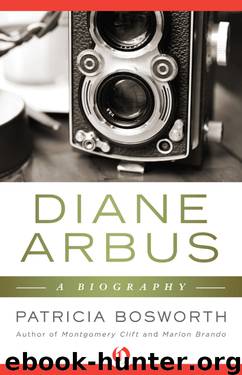Diane Arbus by Patricia Bosworth

Author:Patricia Bosworth [Bosworth, Patricia]
Language: eng
Format: epub
ISBN: 978-1-4532-4499-9
Publisher: Open Road Integrated Media LLC
Published: 2012-04-04T22:00:00+00:00
25
ALTHOUGH THERE WERE A great many fine women photographers working during the sixties (Margaret Bourke-White, Louise Dahl-Wolfe, Eve Arnold, Toni Frissell, Ruth Orkin, Inge Morath, to name only a few), Diane did not associate herself with them. With the exception of Lisette Model, she never sought out women photographers for either advice or friendship. But she did bring her photographs for Tina Fredericks to comment on; she continued to do so even after Tina had left magazines and gone into real estate on Long Island.
Diane would also show her contacts to Walter Silver, a documentary photographer who lived near her in the West Village. Diane liked his work and he liked hers. “We’d compare prints,” Silver says, and then sometimes Diane would have coffee with him at the Limelight, where many photographers still hung out—photographers like Weegee, Robert Frank, and Louis Faurer. “We’d all sit together at a big table and Diane would sit with us,” Silver adds. “She’d never say a word—she’d just listen and then suddenly you’d look up and she’d be gone. She was the only woman who ever was in our little group.”
Which was her choice, of course, but some people got the feeling that Diane thought of photography as a man’s profession. “I remember, though, that once I mentioned that women might be better photographers than men because women can inspire greater confidence,” John Putnam noted, “and Diane said, ‘Look, I’m a photographer, not a woman photographer.’ ”
As for making a great photograph, Diane believed men and women were equal, but she also knew that for many of her magazine assignments she was being paid half what a man would be paid and this bothered her. Still, photographing for magazines was the only way to survive; all the photographers she respected did magazine work. Walker Evans, for example, had subsisted for years on the money he earned from Fortune. He was contracted to do one tycoon a month for the magazine.
Marvin Israel wanted Diane to meet Evans, who had encountered Helen Levitt and Robert Frank at crucial times in their careers. Diane was at a turning point in hers, but she was afraid to meet Evans, so she kept putting it off. She was still struggling to find her themes and master a style. She was afraid he wouldn’t like her work, wouldn’t like her. She revered Evans—revered his clear, straightforward portraits of Hart Crane and Lincoln Kirstein, his secret candids of subway passengers, his photographs of empty rooms and clapboard auto shops and peeling billboards and, of course, the moving documents of impoverished sharecropper families he’d taken during the Depression for the Farm Security Administration in collaboration with James Agee’s text for Let Us Now Praise Famous Men.
To Evans, the artist was an image-collector—“He collects things with his eye.” He once said: “The secret of photography is that the camera takes on the character and the personality of the handler. The mind works on the machine.”
When Diane finally met him, Evans was fifty-nine and
Download
This site does not store any files on its server. We only index and link to content provided by other sites. Please contact the content providers to delete copyright contents if any and email us, we'll remove relevant links or contents immediately.
Shoot Sexy by Ryan Armbrust(17637)
Portrait Mastery in Black & White: Learn the Signature Style of a Legendary Photographer by Tim Kelly(16932)
Adobe Camera Raw For Digital Photographers Only by Rob Sheppard(16880)
Photographically Speaking: A Deeper Look at Creating Stronger Images (Eva Spring's Library) by David duChemin(16598)
Bombshells: Glamour Girls of a Lifetime by Sullivan Steve(13949)
Art Nude Photography Explained: How to Photograph and Understand Great Art Nude Images by Simon Walden(12953)
Perfect Rhythm by Jae(5304)
Pillow Thoughts by Courtney Peppernell(4188)
The Book of Joy by Dalai Lama(3880)
Good by S. Walden(3467)
The Pixar Touch by David A. Price(3343)
A Dictionary of Sociology by Unknown(2998)
Fantastic Beasts: The Crimes of Grindelwald by J. K. Rowling(2975)
Humans of New York by Brandon Stanton(2814)
Stacked Decks by The Rotenberg Collection(2795)
Read This If You Want to Take Great Photographs by Carroll Henry(2653)
On Photography by Susan Sontag(2562)
Insomniac City by Bill Hayes(2477)
Photographic Guide to the Birds of Indonesia by Strange Morten;(2476)
